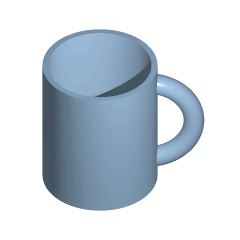It’s just about at that point where I am hit with nostalgia of the past year and excitement for the coming year. This time around, however, that excitement is accompanied by sadness – I will be graduating from James Madison University and leaving many of the good friends I’ve made here to continue on in my graduate studies.
But this post isn’t to dwell on such things; instead, I wanted to do a recap of something which has brought me great joy in the past year – my project on 3D printing mathematical objects!
Update (5/16/17): Check out my picture post to see high resolution pictures of all the objects I printed during this project!
The Start of an Idea
Здравствуйте! That means “Hello” in Russian – but forget that, I’m sure we can go with a much more informal Привет at this point! I was in the Math in Moscow program in the Spring of 2016, taking courses in Algebraic Geometry, Commutative and Homological Algebra, and Algebraic Topology. It was there that I learned about a fascinating concept: homotopy equivalence. Two topological spaces are considered homotopy equivalent if there exists a homotopy between them…just kidding – that’s a ridiculous (albeit technically correct) definition! Think about topological spaces as geometric objects, a ball, a square, a donut, or even your shoe. Then one object is homotopy equivalent to another if you can shape the first – bending, stretching, or shrinking, but never cutting or glueing – into the second. Note this can transcend dimension, a 3D ball is homotopy equivalent to a point! The classic example of a two objects that are homotopy equivalent is a donut and a coffee cup (see below). More information is given in my first blog post on this project.

Upon learning about some wildly unintuitive homotopies (one of my favorites is that a 3-sphere minus a torus is homotopy equivalent to the disjoint union of two solid tori), I had the idea to utilize 3D printing. I had done a project on 3D printing knot invariants with Laura Taalman at JMU my freshman year (final results pictured below), so I thought it was only right to finish off my undergraduate career by doing another 3D printing project with her.

She encouraged me to apply for the Shapeways Education Grant, which I was very happy to end up receiving. I want to thank Shapeways for this grant that allowed me to utilize their fantastic resources and focus on the designing process instead of the troubleshooting that is so often necessary when working with 3D printers! Once the year began, we got started!
Let the Printing Began!
We wanted to start off simple: a sphere minus a point is homotopy equivalent to a single point. We used Mathematica to create an animation of this homotopy, but I quickly became enamored with Fusion 360. Though Mathematica 11 has some nice 3D printing features built into it, you can attribute the decision to switch to my laziness – Fusion 360 had such a nice user interface with a ton of very useful (and easy to learn) tools.
I began to design a whole array of objects: The Perko Knots on a praxinoscope, the Rook’s Graph and (in the case of n = 4) the strangely non-isomorphic Shirkhande Graph, all the while making time for some interesting mathematics. As the fall semester wore on, we approached the first major capstone of this project: An invited talk at the 2017 Joint Mathematics Meetings in January. Not only was it a thrill to be able to share what I had been working on, but I found it to be an invaluable experience to learn from some of the people I consider to be pioneers in the field of mathematical 3D printing.
Let the Printing End!
Alas, this cannot be a complete summary, for the year has not finished! But I will wrap up this post by describing what my plans for the end of the semester are. The math community here at JMU has given so much to me, so I thought it would be nice for the second capstone of my project to involve giving back to that community.

Book embedding of the complete graph on five vertices
The idea of a book embedding of a graph is, in my opinion, very interesting. The entire concept deals not necessarily with some abstract graph, but investigates the possibilities of embedding that graph in what looks like a – well – book! I believe my final goal is a perfect mix of mathematics and 3D printing – I want to
- Design and 3D print book embeddings of the Rook’s Graph and the Shrikhande graph, and
- Characterize the book thickness of these two graphs, i.e. the minimal number of pages needed to embed the graph.
I want to give these last two prints to the JMU math department to hang in the lobby of Roop Hall, along with a plaque describing the mathematical wonders behind both the graphs and their book embeddings.
Once I finish that, I will finally feel like I put the Shapeways Education Grant to good use! I wanted to finish by again thanking Shapeways for that grant, thanking Laura for agreeing to work on this project with me, and of course, thanking you the reader. I hope you enjoyed!
Jonathan Gerhard





Pingback: The Picture Post | Mathematical ADD
Pingback: Virginia student uses 3D printed models to demonstrate mathematical concept of topology - Printenizer
Pingback: Modelle aus dem 3D-Drucker machen mathematische Strukturen fassbar
Pingback: Shapeways Education Grant Stories: Jonathan Gerhard’s 3D Printed Visualizations of Topological Homotopies - Shapeways Magazine